|
|
Selene

|
|
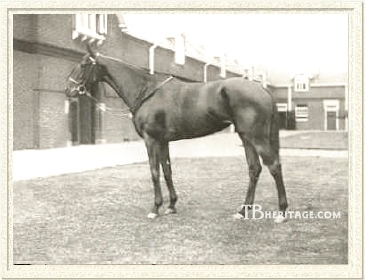 |
|
|
Selene was a second generation member of Lord Derby's breeding program for the Stanley House Studs. She was a top class runner, and as a broodmare, produced a third generation that had dramatic implications on the breed both in the short and long term. She produced fourteen foals, four of which -- Hyperion, Sickle, Pharamond II, and Hunter's Moon -- became outstanding international sires, while her daughter All Moonshine became the ancestress of the important stallions Mossborough and Sir Tristram.
|
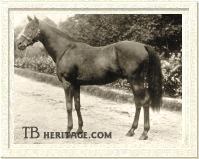
Chaucer

Serenissima
| |
Selene was bred in England by the 17th Lord Derby, and a daughter of his homebred foundation sire Chaucer (by St. Simon - Canterbury Pilgrim). A useful handicapper with victories up to eleven furlongs, Chaucer wasn't a patch on his younger half-brother, the great stayer Swynford. As a stallion for Lord Derby at Woodland Stud in Newmarket, he was a good sire, but his fillies were better than his colts, just as he proved a better broodmare sire than a sire. His best colts were Stedfast, Prince Chimay, Dansellon, and Lord Chaucer; while his most important daughters included the champion Selene (subject of this portrait), and classic winners Canyon (1,000 Guineas) and Pillion (1,000 Guineas), as well as the great broodmare Scapa Flow (dam of Fairway and Pharos).
Selene's dam was Serenissima, a Derby-bred daughter of Minoru and Gondolette. Purchased for 1,550 guineas, Gondolette's value to Lord Derby was her unusual pedigree, by Loved One out of Dongola by Doncaster. Loved One won the Cheveley Park Stakes at two, and the Wokingham Stakes at three. He was not a particularly effective sire of runners in Ireland, but his value to Lord Derby was that he was by See Saw out of the mare Pilgrimage, thus a half-brother to Lord Derby's foundation mare Canterbury Pilgrim.
|
The plan was to breed Gondolette and her progeny to the descendants of Canterbury Pilgrim, primarily her outstanding stallion sons Chaucer and Swynford. For her previous owner, Gondolette had produced the stakes winners Let Fly (by White Eagle) and Great Sport (by White Eagle's sire Gallinule), the former being the better runner -- winner of the Dewhurst at two and Champion Stakes at three -- and the latter being the more influential sire (dam's sire of Challenger II, Osiris II, Brueghel and Bozzetto).
At the Derby stud, Gondolette produced only one foal by Chaucer, the winning filly Casa d'Oro (1919) who did nothing as a broodmare. Bred to Chaucer's son Stedfast, Gondolette foaled the minor stakes winner Piazzetta (1923). When bred to Swynford, however, she got 1,000 Guineas winner Ferry (1915), and Sansovino (1921), who brought home the 17th Earl's first winner of the Derby Stakes at Epsom, the race named for his ancestor, and dramatically proving the wisdom in the inbreeding to Pilgrimage.
At the time of her purchase, Gondolette was carrying the filly Serenissima (1913), by the Derby winner but unsuccessful sire Minoru. Serenissima was a non-winner from six starts at two, but twice victorious in nine starts at three, up to twelve furlongs. As a broodmare, she proved much more capable. Her foals included Tranquil (by Swynford, so again, doubling up on Pilgrimage), winner of the 1,000 Guineas and St. Leger Stakes; Bosworth (by Son-In-Law), winner of the Ascot Gold Cup; and the subject horse, Selene (by Chaucer), champion filly of her generation.
Selene was also inbred to Pilgrimage 3x4 through Canterbury Pilgrim and Loved One, and also significantly linebred to Galopin, Hermit, Doncaster, and Beadsman. Like Canterbury Pilgrim and many of her descendants, including Chaucer, Selene was small, maturing only at 15.2 hands, and therefore not considered a likely candidate for the classics of her year, so trainer George Lambton opted not to nominate her for the classics as a yearling. The little filly proceeded to prove him wrong.
Selene on the Turf
Selene started eleven times at two and won eight of them, including the Rous Memorial Stakes (6f. Goodwood), the Cheveley Park Stakes (6f. Newmarket), and ended the season with a shared victory in the Houghton Stakes (8f. Newmarket), in a dead heat with Fodder, giving that one eleven pounds in the weight spread. Never out of the money, she was also second twice, including the Queen Mary Stakes, and third once.
At three, Selene duplicated that record, with eight wins in eleven starts, scoring in the Nassau Stakes (10f. Goodwood), the Park Hill Stakes (over the St. Leger Course at 14f. 127 yards at Doncaster), Liverpool Autumn Cup (10f. Liverpool), and ended the season with a definitive win in the Hampton Court Great 3YO Stakes (13f. Hurst Park) winning by three lengths against a top field that included Diligence, Pondoland, and the brilliant Lady Juror. She was also second in the Coronation Cup (Epsom) to the older horse Franklin, and Falmouth Stakes (Newmarket).
By year's end, it was obvious that Selene was the best filly of her age in training, better even than Oaks winner Pogrom, 1,000 Guineas winner Silver Urn, or Soubriquet, who placed second in both classics. It's generally conceded that, had she been entered, she was probably capable of beating the colts in the St. Leger, won that year by Royal Lancer, a horse not nearly in her class.
As noted, Selene was small but she was extremely well made, with excellent balance, perfect legs with good bone, and great depth through the chest and rib cage. If she could be faulted, it would be for having short legs, but they carried her fast enough, and she remained sound throughout her training. A photo shows her with a remarkably long forearm and short cannon. Selene was also extremely competitive and gave her best every time. She was a bay with no white markings, and showed much of the quality and refinement of her sire, Chaucer.
So well had Selene come along by the end of her three-year-old year, that Lambton eagerly anticipated her racing prospects at four, only to find that Lord Derby, usually open to his advice, had already decided to retire and breed her the next year. Lambton would discover that he had enough depth in the stable to keep him busy, because coming up in the next few crops were Lord Derby's homebreds Tranquil, Pharos, and Sansovino, a half-brother to Selene's dam.
Selene in the Breeding Shed
The Stanley House Stud stud manager, Walter Alston, advised his employer to give Selene a year off before her first mating, presumably to allow the little filly time to more fully mature, but Derby similarly overrode his advice. Selene was therefore bred to the home sire Phalaris (Polymelus - Bromus by Sainfoin) at Side Hill Stud in early 1923, producing her first foal, SICKLE, the following February. Selene delivered fifteen foals, one of which died, ten of which won, and six won stakes. All of Selene's foals were bred by the 17th Earl of Derby, and many of their names reflected her own, Selene being the Greek goddess of the moon. |
| PRODUCE RECORD OF SELENE |
| Year | Name | Stats | Sire | Racing (stakes) | Offspring |
| 1924 | Sickle | br.c. | Phalaris | SW at 2 and 3 | Leading Sire in U.S. 2xs |
| 1925 | Pharamond II | br.c. | Phalaris | SW at 2 | a leading sire in the U.S. |
| 1926 | Hunter's Moon | b.c. | Hurry On | SW | a leading sire in Arg. |
| 1927 | Salamis | b.c. | Phalaris | placed at 3 | sire in Ireland |
| 1928 | Guiscard | b.g. | Gay Crusader | SW at 4 (won Queen's Prize) |
| 1929 | Barren (to Phalaris) |
| 1930 | Hyperion | ch.c. | Gainsborough | SW (champion at 3) | Leading Sire in GB 6xs |
| 1931 | Lunette | br.f. | Son-In-Law | died |
| 1932 | Coronal | ch.f. | Coronach | stakes-placed | dam of Afghan II (wnr, LS Chile) |
| 1933 | Barren (to Felstead) |
| 1934 | Hecate | b.f | Felstead | Unraced | Dam of SW Downrush. |
| 1935 | Vale of Lune | br.f. | by Felstead | died |
| 1936 | Night Shift | b.f. | Trimdon | SW (Yorkshire Oaks) | died at 4 |
| 1937 | Moon Priestess | b.f. | Dastur | non-winner | dam of stakes-placed Sabaean (sire) |
| 1938 | Moonlight Run | ch.c. | Bobsleigh | winner | sire in U.S. |
| 1939 | Barren (Precipitation) |
| 1940 | New Moon | ch.f. | Solfo | Unraced | dam of SWs Hervine, New Move, Turn a Penny. |
| 1941 | All Moonshine | ch.f. | Bobsleigh | winner | dam of SWs Eyewash, Mossborough |
| 1942 | Shooting Star | b.f. | Bold Archer | winner |
|
Selene's first foal was SICKLE (br.c. 1924 by Phalaris), born on February 8, so the young mare had apparently conceived on her first cover by Phalaris. He was a medium-sized horse with a hint of his dam's short legs, but built more in the style of his sire Phalaris. Sickle was also an example of the success Lord Derby was experiencing crossing his Chaucer mares with Phalaris, a nick which had already produced Pharos and Colorado.
|
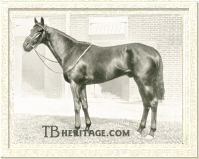
Sickle
| |
Trained by George Lambton, Sickle won three of seven starts at two including the Mersey Stakes, Prince of Wales's Stakes, and Boscawen Post Stakes; second in Middle Park Stakes, New Stakes, July Stakes; and third in the Champagne Stakes. He was ranked at 122 pounds, among the top five or six two-year-olds, behind the highweight The Satrap (126 pounds). At three, Sickle was winless in three starts, although second in the Union Jack Stakes, third in the 2,000 Guineas, and fifth in the Derby. In the latter, he was injured and retired with three wins in ten starts.
|
One of the best of his crop up to a mile, Sickle rested his four-year-old year and at five, stood the 1929 season at Woodland Stud, Newmarket. He was then leased by Joseph D. Widener to stand his first season in America (1930) at Elmendorf Stud in Kentucky, and bought outright by Widener in 1932.
Sickle was an immediate success with good runners both in Europe and America, and was the Leading Sire in the U.S. in 1936 and 1938. His 45 stakes winners included Champion Three-Year-Old Stagehand, Champion Two-Year-Old Male Star Pilot, French Champion Two-Year-Old Filly Gossip II, also Reaping Reward, Brevity, Unbreakable, Silver Spear II, Cravat, Jabot, Versicle, Brownian, Misty Isle, Farmerette, and Fair Weather. Sickle tended to sire precocious sprinters, qualities typified by his son Unbreakable, who passed on the sireline to his son, Polynesian, sire of the great Native Dancer.
Selene's second foal was PHARAMOND II (br.c. 1925 by Phalaris), born on the 17 of January, 1925, and so apparently conceived on her foal-heat following the birth of Sickle the previous year. Pharamond II was also small horse, and similar in type to Phalaris, but blockier than Sickle, and less perfectly made.
|
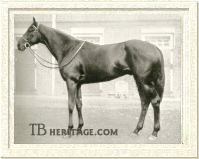
Pharamond II
| |
Likewise trained by Lambton for Lord Derby, Pharamond II was a good two-year-old, although not of the same high class as Sickle. In six starts, he broke his maiden in his last race, when substituting for stablemate Fairway in the Middle Park Stakes; was second twice, in the Buckenham Produce Stakes and Lancashire Breeders' Produce Stakes; and third in the Windsor Castle Stakes. At 110 pounds, he was far behind the division leaders (Fairway was one of three joint-highweights at 126) on the Free Handicap. At three, Pharamond II ran poorly in five starts, again winning only in his final start, the Ellesemere Stakes. He was also fourth in the 2,000 Guineas, and retired with two wins in eleven outings.
|
Lord Derby sold him for £4,000 ($20,000) to a syndicate headed by Hal Price Headley of Beaumont Farm in Kentucky, where he stood his first season in 1929. Headley gained full control of the horse in 1932, and Pharamond II rewarded his patron by siring 35 stakes winners from 399 foals until his death in 1952 at age 27. Pharamond II tended to sire precocious speed, although his best runners included several good middle distance runners and even a few stayers. He was the second Leading Sire in 1938 (behind Sickle), and was among the top five in 1937, 1943, and 1944. His best runner and most influential offspring was Menow, the champion two-year-old male of 1937, and later sire of champions Tom Fool, Capot, and Askmenow. Pharamond II also sired By Jimminy (champion at three in 1944), Apogee (champion filly at two), Cosmic Bomb (co-highweight at two), Whopper, King Cole, High Glee, Easy Mon, Creole Maid, Athenia, Hipparete, Lithe, and Blinking Owl.
|
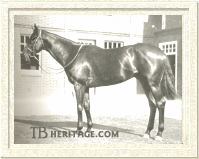
Hunter's Moon
| |
Selene's third foal was HUNTER'S MOON (b.c. 1926 by Hurry On), who, like his older half-brothers, proved short of classic form. As a two-year-old, Hunter's Moon started twice without winning, and was third in the Prince of Wales's Stakes. He ran six times at three, and won the Newmarket Stakes, Gratwicke Produce Stakes, and Newmarket Spring Three-Year-Old Stakes; was second in the Union Jack Stakes, and fourth in the 2,000 Guineas and Derby. He retired with three wins in eight starts.
|
Late in 1929, Hunter's Moon was sold to stand in Argentina, where he became a very successful stallion, although never led the sires' list. In 1945 he was sold to finish out his days in Brazil, and continued to sire top class runners and breeding animals. Hunter's Moon's most important progeny include three classic-winning fillies - Hulla (Polla de Potrancas-Argentine 2,000 Guineas and Gran Premio Seliccion-Argentine Oaks), Hear! (Gran Premio Seleccion), and the outstanding Half Crown (Polla de Potrancas) - as well as Helium, Loretta, Fairplay, Acapulco, Postin, and Chilean and North American stakes winner Halconero (Exterminator Handicap, third Pimlico Cup, etc.). Several of these were out of daughters of Silurian, a son of Swynford, so also inbred to Canterbury Pilgrim. Typical for a stallion whose fillies were better than his colts, Hunter's Moon proved an even better broodmare sire, and he was the leading sire in this category in Argentina for 1954.
After foaling Hunter's Moon in 1926, Selene was sent back to Phalaris and the following spring produced SALAMIS (b.c. 1927 by Phalaris). Unraced at two, Salamis ran five times at three, but could do no better than place. He was sent to stud in Ireland where he generated a surprisingly good record as a sire, although he died before he could really take advantage of it, at age 11 in 1938. The only strain of importance descending from him is through his daughter Music and Song (1938, out of a mare by Sansovino), who was a stakes winner at two, and second in the Irish Oaks. She was the dam of stakes winner Jungle Music, and the third dam of Hotroy, and Precious Will. Salamis also sired the horse Lord Flame, a sire in Brazil.
Selene's fifth foal in as many seasons was GUISCARD (b.c. 1928 by Gay Crusader), who was gelded. A later-maturing horse, he ran for five years, making 35 starts, and won nine races and won as far as 16 furlongs. At four, he won the Queen's Prize (Kempton), and was also second twice in the Chester Cup, and third in the Goodwood Handicap and Churchill Stakes.
Selene did not get back in foal to Phalaris in 1928, and when sent to be covered by Gainsborough in 1929, was slow coming into her heat. The result was that she nearly missed to that sire, and the ramifications from that are mind boggling, since the resulting foal was HYPERION (ch.c. 1930 by Gainsborough).
Hyperion was small to the extreme, and his future uncertain as a youngster until he caught the eye of George Lambton, who grew particularly fond of him. In five starts at two, he won three times, in the New Stakes, Prince of Wale's Stakes, and Dewhurst Stakes; was third in the Boscawen Post Stakes, and only once unplaced, in his racing debut in May. On the Free Handicap, Hyperion was fourth highweighted juvenile at 126, and rated just behind the top weighted colt, Manitoba (127).
|
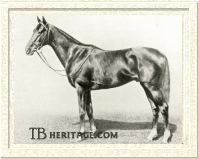
Hyperion
| |
At three, Hyperion won the Derby (setting a new stakes record of 2:34), St. Leger, Chester Vase, and Prince of Wale's Stakes. Lambton left the Derby stable at the end that season, so Hyperion had a new trainer in Colledge Leader at four, but the year proved a disappointment. In four starts, he won the March Stakes, Burwell Stakes, was second in the Dullingham Stakes, and a tired third in Felicitation's Ascot Gold Cup. With nine wins in thirteen starts, the cocky little Hyperion, had won the hearts and admiration of his fans. He was one of the best Derby winners of the century.
|
Hyperion's record at stud ranks him as one of the best stallions of all time. Leading sire six times (1940, 1941, 1942, 1945, 1946, 1955), he sired 118 stakes winners including eight classic winners -- Owen Tudor (1941 Derby, and 1942 Ascot Gold Cup), Godiva (1940 1,000 Guineas and Oaks), Sun Chariot (1942 1,000 Guineas, Oaks, and St. Leger for King George VI), Hycilla (1944 Oaks and Champion Stakes), Sunstream (1945 1,000 Guineas and Oaks), Sun Castle (1941 St. Leger), Hypericum (1946 1,000 Guineas), and in America, Pensive (1944 Kentucky Derby and Preakness).
Among Hyperion's other outstanding runners were Opaline II, Aureole, Gulf Stream, Eastern Emperor, Heliopolis, Double Eclipse, High Hat, Hornbeam, High Stakes, Hyperbole, Saturn, and Khaled. His outstanding sons at stud were legion, and included Aureole, Heliopolis, Gulf Stream, Helios, Ruthless, Deimos, Aristophanes, Selim Hassan, all leading sires at least once; as well as Owen Tudor, Alibhai, Stardust (sire of Star Kingdom), Rockefella, High Hat, and numerous others. Hyperion was the Leading Broodmare Sire in England twice (1948, 1957).
Hyperion was Selene's masterpiece, and his birth marked a pivotal year in her broodmare career. Her first six foals had all been male, five of which were stakes winners, and five became successful sires to one degree or another, and the sixth was a gelding. In 1931, Selene's foal, a brown filly by Son-In-Law, died shortly after birth. After this, she produced seven more foals, all but one a filly, and only one major stakes winner. She was no longer bred to the top class stallions available to Lord Derby.
In 1932, Selene produced CORONAL (ch.f. 1932 by Coronach), who made only one start at two and ran unplaced in that. At three, she ran ten times, and won just once, in the minor Freckenham Stakes (Newmarket). She was second twice, in the Dukeries Foal Plate (Nottingham), Durham County Produce Stakes (Stockton), and third three times, in the Coronation Stakes (Ascot), Falmouth Stakes (Newmarket), and Lingfield Autumn Oaks. Obviously not nearly the same class as her brothers, Coronal embarked on an equally disappointing stud career, getting just one winner, Afghan II (1939 by Mahmoud), who won just one minor race before being sent to stud in Chile. There he topped the Leading Sires list twice (1947, 1948), with his best runner being Beauchef. His most important offspring internationally was the mare Maria Bonita, granddam of the mighty Chilean import, Cougar II, an outstanding runner in the U.S.
Coronal also produced the filly Solitaire (1942 by Solario), who, although unraced, was the dam of seven winners, including stakes winner Lady Midge (by Nearco). The most influential of Solitaire's offspring was Walking High (by Court Harwell), whose daughter Arctic Walk produced Grade 2 winners Icelandic and Snow, and a daughter Maire Viita, dam of Australian Grade 1 winner Our Maizcay.
Selene was barren (to Felstead) for 1933, and the next year produced HECATE (b.f. 1934 by Felstead). Hecate was unraced, and as a broodmare, had five foals, of which two raced, and both were winners. One of these was the stakes winner Downrush (by Bobsleigh).
In 1935, Selene lost another filly, this one by Felstead, but the following spring she produced NIGHT SHIFT (b.f. 1936 by Trimdon). Night Shift was unraced at two and made only three starts at three, with her sole victory coming in the prestigious Yorkshire Oaks (12f.). Unfortunately, she died the next year, so left no record as a broodmare.
Selene's next foal was MOON PRIESTESS (b.f. 1937 by Dastur), who was unplaced in four starts at two and two more starts at three. She produced seven foals, five of which raced, but only one could win, that being Sabaean (1945 by Blue Peter). A winner at two, he was third in the Moulton Stakes the same year, and although winless at three, was second in the Coventry Three-Year-Old Stakes and third in the Blue Riband Trial. Sent to stud in New Zealand, he proved extremely useful, getting New Zealand Derby winner Burgos, and many good broodmare daughters.
Selene's eleventh foal was MOONLIGHT RUN (ch.c. 1938 by Bobsleigh), who, in two years racing, could only win once in six starts. Like his half-brothers Sickle and Pharamond II before him, Moonlight Run was sold to stand in the U.S., at the McCarthy Ranch in California. There he put together an unimpressive stud career, with 108 foals, and three stakes winners. The best of these was the good handicap mare Mary Machree (1951), winner of $107,975 including victories in the Vanity Handicap and Santa Monica Handicap. She later produced the good stakes winners Hill Clown and Hill Circus, both by the inbred Hillary, a son of Khaled (by Moonlight Run's half-brother Hyperion) out of a mare by Boswell (a son of Selene's half-brother Bosworth).
Moonlight Run also sired the good broodmare Moonrise (1947), who produced stakes winners Penumbra and Chicha. Penumbra in turn became the dam of the good stakes winner Hill Shade (also by Hillary), who produced the English champion juvenile colt J.O. Tobin, also champion sprinter in the U.S. at four; and the 1,000 Guineas and Oaks winner Mysterious.
|
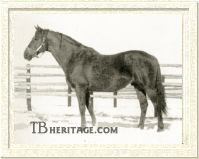
Moonlight Run
| |
Moonlight Run's sire, Bobsleigh, was a Derby-bred son of Gainsborough (and Oaks winner Toboggan), so the cross was very similar to the one that produced Hyperion, by Gainsborough. Gainsborough had also sired Solario, the sire of Dastur (who sired Moon Priestess), but the relationship was much further removed than with Bobsleigh. Moonlight Run's full sister, All Moonshine, was also a minor winner, but proved a broodmare of tremendous importance.
|
In 1939, Selene was barren to the cover of Precipitation. She was bred back to Solfo, a son of Solario (by Gainsborough) who had shown some class on the track with wins in the Jockey Club Stakes, King Edward VII Stakes, Prendergast Stakes, Gratwicke Stakes and Ham Stakes. Solfo entered stud in 1940, but was injured and had to be destroyed that same year. The result of his mating with Selene was NEW MOON (ch.f. 1940 by Solfo), who never raced.
New Moon produced ten foals, eight to race, all of which won, including the stakes winning colts Turn a Penny (c. 1947 by Umidwar), Hervine, and the filly New Move (f. 1958 by Umberto), and stakes-placed runners Moon Game, and Moongate.
New Move was the best of the three, winning the Chesham Stakes and Lavant Stakes at two, the only year she raced. New Move...dam of New One, New Way (f.by Klairon; dam of Star Way, sw, sire.
New Moon's other foals included the filly Port Luna (by...; dam of stakes winner Prince Moon by Prince Bio; and Hazy Moon (by Umidwar, dam of Haytime by Alycidon, and granddam of Haymaking (by Galivanter.
In 1941, Selene dropped her last foal of importance, the filly ALL MOONSHINE (ch.f. 1941 by Bobsleigh), by far her best producing daughter. This was a full sister to the minor winner Moonlight Run, but here the return to Hyperion's sire Gainsborough worked it's magic, although not on the track. In two starts at two, All Moonshine's best effort was a fourth in the Alington Plate at Newmarket. At three, she ran five times, and won the Haughley Stakes at Newmarket, but nothing else. As a broodmare, she had thirteen foals, eleven runners and eight winners. Her first two foals were the stakes winners Eyewash and Mossborough.
Eyewash (f. 1946 by Blue Peter) won the Lancashire Oaks, was second in the Galtres Stakes and third in the Yorkshire Oaks. Eyewash's foals included Park Hill Stakes winner Collyria (by Arctic Prince), and three other stakes winners, Sijui (1954 f. by Sayajirao), Varinia (1963 f. by Charlottesville), and Amfissa (1961 f. by Crepello). Eyewash's daughters bred on with strength, tending to fall back on Blue Peter's stamina. Collyria was the dam of Biomydrin (by Ballymoss), winner of the Ormonde Stakes and second in the Ascot Gold Cup. Collyria also became the third dam of Australian Horse of the Year Might and Power. Visor II (by Combat) produced another top stayer in Raise You Ten (by Tehran), winner of the Yorkshire, Doncaster, and Goodwood Cups. Eyewash's daughter Fiddlededee (by Acropolis) produced Irish St. Leger winner Mountain Lodge, and was the granddam of G1 winners Frenchpark and Pearly Shells. At least two other Eyewash daughters were stakes producers.
|
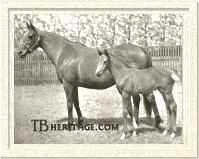
Selene with All Moonshine as foal
| |
All Moonshine's second foal, Mossborough (c. 1947 by Ballymoss) won the Liverpool Autumn Cup and Knowsley Dinner Stakes at three, and the Churchill Stakes at four, but was much more successful as a sire. In 1958, Mossborough's son Ballymoss won the Irish Derby and St. Leger Stakes, besides placing in the Epsom Derby, leading his sire to the sire championship that year (and won the Prix de l'Arc de Triomphe the next year). Mossborough also sired the 1958 Belmont Stakes winner Cavan, and later, the 1963 Oaks winner Noblesse, and 1965 Irish St. Leger winner Craighouse.
|
All Moonshine's stakes-placed daughter All My Eye (1954 by My Babu) was the granddam of the great New Zealand sire Sir Tristram, and the top racemare Variety Queen, dam of Variety Road and Variety Baby. Hers is also the family of Topanoora.
All Moonshine's daughter Parthenope (1948 by Nearco) produced Gran Premio di Milano (G1) winner Epidendrum (by Ribot). Another daughter, French Polish (1953 by Sicambre) was the dam of Ribotina (by Ribot), a mare who established a strong family in the U.S., including the Kentucky Oaks winner Lucky Lucky Lucky, and 2,000 Guineas winner Entrepreneur.
Late in life, All Moonshine was brought to the U.S. and produced her last two foals here, although they did nothing to enhance her reputation.
Selene's last foal was SHOOTING STAR (b.f. 1942 by Bold Archer), who made her only start a winning one. With only one foal, she did nothing as a broodmare. Her dam died the same year, and may have died foaling her.
Selene was 23 years old at the time of her death. She had produced fourteen foals, ten winners, six stakes winners, including the great champion Hyperion. She had seven male foals, six of which became successful sires, four of those being leading sires or among the leading sires where they stood, including England, the U.S., and Argentina. Of her seven daughters, three became stakes producers, and two were responsible for two more leading sires in Chile and New Zealand. That's a heady influence, and makes Selene possibly the most influential broodmare of the Twentieth Century.
-- Anne Peters |
|
|
|

